 Technology
Technology  Technology
Technology  Humans
Humans 10 Everyday Human Behaviors That Are Actually Survival Instincts
 Animals
Animals 10 Animals That Humiliated and Harmed Historical Leaders
 History
History 10 Most Influential Protests in Modern History
 Creepy
Creepy 10 More Representations of Death from Myth, Legend, and Folktale
 Technology
Technology 10 Scientific Breakthroughs of 2025 That’ll Change Everything
 Our World
Our World 10 Ways Icelandic Culture Makes Other Countries Look Boring
 Misconceptions
Misconceptions 10 Common Misconceptions About the Victorian Era
 Mysteries
Mysteries 10 Strange Unexplained Mysteries of 2025
 Miscellaneous
Miscellaneous 10 of History’s Most Bell-Ringing Finishing Moves
 Technology
Technology Top 10 Everyday Tech Buzzwords That Hide a Darker Past
 Humans
Humans 10 Everyday Human Behaviors That Are Actually Survival Instincts
 Animals
Animals 10 Animals That Humiliated and Harmed Historical Leaders
Who's Behind Listverse?

Jamie Frater
Head Editor
Jamie founded Listverse due to an insatiable desire to share fascinating, obscure, and bizarre facts. He has been a guest speaker on numerous national radio and television stations and is a five time published author.
More About Us History
History 10 Most Influential Protests in Modern History
 Creepy
Creepy 10 More Representations of Death from Myth, Legend, and Folktale
 Technology
Technology 10 Scientific Breakthroughs of 2025 That’ll Change Everything
 Our World
Our World 10 Ways Icelandic Culture Makes Other Countries Look Boring
 Misconceptions
Misconceptions 10 Common Misconceptions About the Victorian Era
 Mysteries
Mysteries 10 Strange Unexplained Mysteries of 2025
 Miscellaneous
Miscellaneous 10 of History’s Most Bell-Ringing Finishing Moves
10 Ways Religion And Superstition Have Led To Animal Cruelty
Harming animals is widely considered one of the lowest and cruelest acts any human could do. In some cases, religion and superstition have played pivotal roles in leading humanity to cause great harm to helpless creatures both great and small.
Warning: This list contains graphic photos that may be disturbing to some readers.
10Goat Sacrifices For Shakti

Shaktism is a sect of Hinduism that focuses on the worship of the Hindu Divine Mother along with various consorts of Shiva and Vishnu. One of these forms is the goddess Kali, consort of Shiva. The goddess is known to favor animal sacrifices—goats in particular. Killing a goat in her name is believed to relieve one of negative emotions such as fear, anger, and jealousy.
One notable example is in India’s Kamakhya Temple, a popular tourist destination. There, goats and pigeons are ritualistically sacrificed in front of foreign onlookers.
The act of animal sacrifice has been in existence for centuries, and over the years many different authorities have tried to put a stop to it with varying degrees of success. For instance, the high court in Orissa imposed a ban on animal sacrifice, yet a few districts in the province still manage to contravene the order.
9Kosher Killings That Aren’t Kosher At All
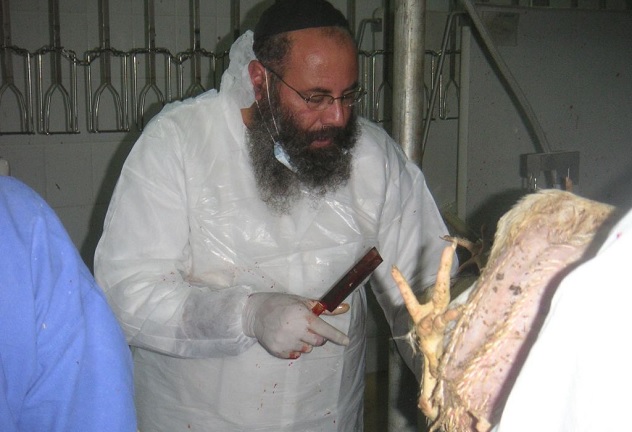
Kosher food adheres to strict guidelines based on Jewish tradition. Bulls, cows, sheep, and other livestock must be humanely slaughtered by a shohet—a butcher certified by a rabbi or Jewish court to kill animals for food as prescribed by Jewish law. The shohet performs a deep slice on the throat of the animal which renders it instantaneously unconscious. A quick and painless death occurs mere moments later.
Many countries have laws requiring that animals be stunned or sedated prior to being slaughtered, but an exemption is often granted based on religious practices such as halal (the Muslim practice). However, in countries such as Sweden and Denmark, the animal must be stunned regardless of any contradicting beliefs.
The problem comes when so-called kosher killings aren’t kosher in the least. In the United States, PETA discovered in both 2004 and 2007 that some kosher slaughterhouses in Iowa and Nebraska were violating both federal and kosher law by murdering animals that were fully conscious. Workers would dig into their throats with a hook to speed up the bleeding process. Some of the cows were even seen attempting to stand up as their blood flowed freely.
8Killing Owls Over Superstitious Fear
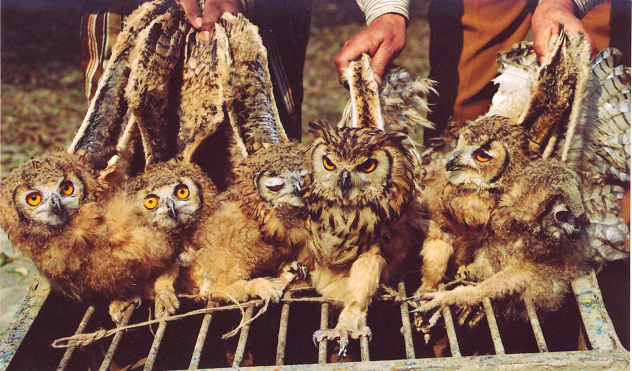
There are many superstitious beliefs associated with owls. Romans believed that owls were “suspicious” due to their nocturnal activities, and they felt that the creatures foretold death—as in the cases of Julius Caesar, Augustus Caesar, and Marcus Agrippa. Owls were actually burned during festivals and their ashes scattered in the Tiber River.
As centuries passed, old beliefs gave way to new ones, such as how an owl hooting or screeching meant the death of a newborn. Owls were also associated with witches and ghosts—an owl nesting in a house meant it was haunted. Similarly, dreaming of an owl meant you would soon encounter an accident, while major misfortune would befall you if you encountered an owl during daytime. Such beliefs have led to the sacrificial killings (such as at the Indian Diwali festival, for example), hunting, and illicit trading of these unfortunate creatures.
7Black Dog Syndrome

For centuries, various religious and superstitions have hounded darker-colored animals. For instance, during the early days of Christianity, a large black dog called the grim was believed to frequent graveyards. A certain grim called the “Black Dog of Newgate” was said to go near the window of sick people, indicating they were about to die.
It was also once believed that vampires took the form of black dogs. Eastern European lore speaks of how these beasts were seen roaming the countryside right after livestock had been attacked. This led many people to believe these dogs were a malevolent force and were behind the attacks. These tales also found themselves ingrained in North American culture, oftentimes called “hellhounds.” More recently, tales of the ill portents brought by the grim became famous once again in Harry Potter and the Prisoner of Azkaban.
All of this results in what animal shelter workers and activists call “Black Dog Syndrome.” Hundreds of years of behavioral conditioning have led humans to see dark-furred canines as less adoptable, less friendly, and more intimidating. Compared to lighter-colored pets, pet shops find black dogs harder to sell. In animal shelters, they are often the last to find a home, meaning they either live their entire life in a kennel or they become the first to be euthanized.
6Eating Dogs To Cure What Ails You

The Igorot, an indigenous people from the northern mountains of the Philippines, believe that dogs are spiritual guardians with mystical characteristics. Dog’s teeth are said to protect from snake bites and even lightning. These teeth, imbued with magical properties, are typically worn as a necklace or charm. Similarly, Igorots wear dog tattoos in order to invoke the canines’ agility and power.
In addition, Igorots occasionally eat dog meat during their healing rituals. This is done very rarely, though, and is reserved only for the most special occasions. Unfortunately, the tribe is not known for that, thanks to their participation in the 1904 World’s Fair held in St. Louis, Missouri. The Philippines was under American rule at the time, and the organizers of the Fair brought in around 1,100 Filipinos in order to parade them around for awestruck American fairgoers.
Despite the eating of dog meat being a very rare practice of theirs, the Fair wanted to sell the Igorots as a “savage” tribe with a voracious appetite for pooch. The tribe went along with it because while their beliefs are strong, the allure of money was even stronger. The city provided them an “ample” supply of 20 dogs per week to butcher and eat onstage. Later on, this number grew exponentially due to the popularity of the spectacle. The poaching of dogs in the vicinity of the Fair became so rampant that residents were actually told to leave their dogs at home lest the worst happen.
5Endangering The Aye-Aye Because Of Their “Evil” Finger
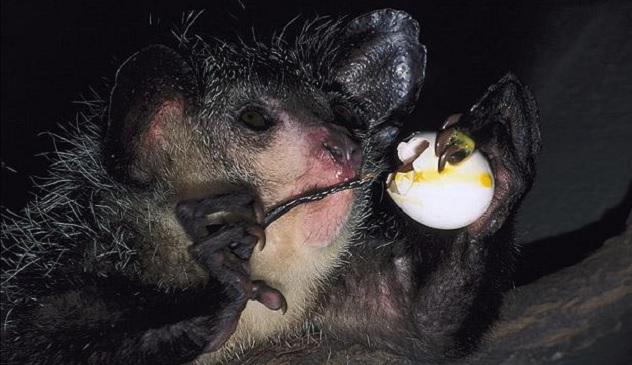
The aye-aye—a tiny creature found in Madagascar—is a harmless mammal that the people of Madagascar have rendered endangered. This is almost entirely due to one thing: its long middle finger. This is an evolutionary tool used to snatch insects inside tree bark and branches, but superstitious and paranoid natives don’t see it that way. The Malagasy people believe that the aye-aye pointing its middle finger toward a human means certain doom. They believe these creatures will crawl into their homes at night and use those long, pointy fingers to stab them in the heart.
What better way to stop that from happening than with preemptive aye-aye murder? If a Malagasy native sees an aye-aye coming toward them—which is very likely to happen as the animal is friendly and curious by nature—they’re very likely to greet the creature with a bullet or two, dropping them dead on the spot. While the aye-aye probably doesn’t use its middle finger to communicate its displeasure toward humans, it should probably start doing so.
4Hunting The Thylacine Because It Might Be Evil

The thylacine has been extinct since the 1930s thanks to both the changing environment brought about by European settlers and people’s crazy superstitions. While the thylacine was certainly an apex predator, there’s no denying that settlers made some very wild and exaggerated assumptions about them.
As myths of vampires and werewolves permeated in campfires and lodges, an unnatural evil became associated with the thylacine. The creatures were often associated with mysterious deaths in livestock such as sheep and cattle, due to their powerful jaws that could crush bone and muscle. In addition, a photograph from the 1920s depicted the creature with a chicken in its mouth. This led many to believe that thylacines were vicious poultry thieves, and the the government quickly offered a £1 bounty for every thylacine killed.
A children’s encyclopedia published during the 1940s told the younger generation how these beasts—described as “a sort of nightmare wolf“—regularly engaged in “blood-feeding” frenzies where they would hunt their prey to drink their blood rather than for meaty nourishment. This erroneous belief maintained its popularity until well into the 1980s.
In 2011, a study conducted by the University of New South Wales concluded that these accusations and beliefs were unfounded—the jaws of the thylacine were not nearly as strong as widely believed by early settlers. In fact, they were probably not even strong enough to snare sheep in the first place.
3Hanging A Bull To Bring Forth A Year Of Peace
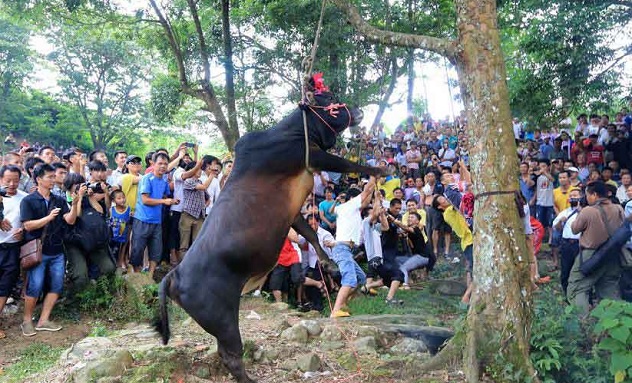
Travel websites in China freely mention the Naoyu festival—a religious gathering held every June 2 of the Chinese lunar calendar. It’s a celebration of various ethnic groups such as the Dong, Yao, and Miao. Like with most ceremonies, the Naoyu features dancing, singing, and traditional folk gatherings. Bullfighting also figures prominently.
However, something far more dastardly occurs there that is rarely advertised to tourists. The locals begin the day innocently enough by catching fish and offering prayers. This day culminates, however, with brutal animal murder. They grab one of the bulls, tie a noose around its neck, and hang the struggling animal until it dies. This slow and painful death is believed to bring about a peaceful year and a prosperous harvest for the community.
2Brutally Killing Bear Cubs So They Can Join The Spirit World
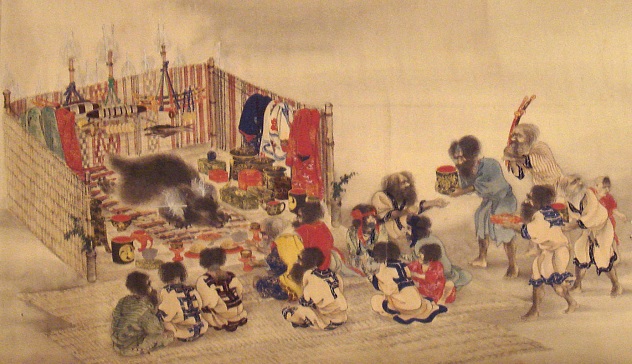
Brown bears are revered by the Ainu people of Japan to the point that they regard the cuddly creatures as gods. The Ainu also believe that since gods dwell in the spirit world, that is where the bears ought to be sent.
The Iomante ceremony, therefore, is loosely translated as “sending off divine beings to another world.” The Ainu begin the process by grabbing a bear cub from the wild. If the mother is found anywhere near her baby, she is killed immediately so as to not disrupt the process. The cub is then brought back to the village and nursed to full health. If the cub is especially young, the women of the village will help it grow by breastfeeding it.
Around a year or two later, preparations for the grisly festivities truly begin. The creature is taken out of the holding cage and tied down in the center of the village. The villagers begin shooting it with blunted arrows, then move on to deadlier ones. If the bear is still alive after all this, the natives will either crush its head with a huge log or simply strangle it to death. The creature’s brain, tongue, and eyeballs are then removed and the skull is filled with flowers.
The neighboring Nivkh people—or Gilyaks—from Sakhalin Island also have a similar ceremony. A cub is nursed to full health and then led out for execution. The chief—who has known it for all its life—speaks to the cub, his reassuring words calming the beast. It is then shot with an arrow through the heart. Once the deed is done, the bear’s skin is removed and its meat consumed.
1Sacrificing Hundreds Of Thousands Of Animals To A Hindu Goddess
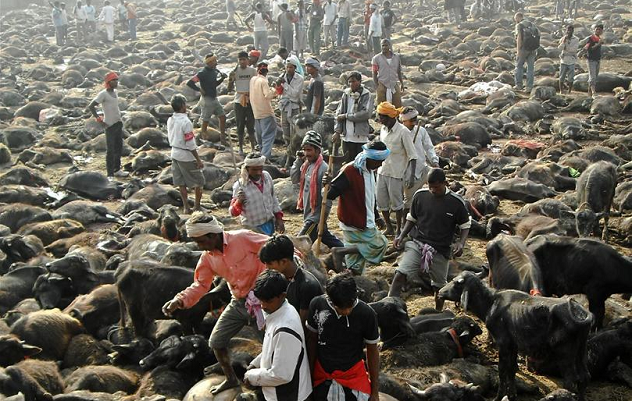
Few animal sacrifices come close to the extremes of the Gadhimai festival held in Nepal. Every five years, millions flock to the holy temple in Bariyapur to appease Gadhimai, the Hindu goddess of power. Up to 400,000 animals are slaughtered in just a span of two days. Part of this sacrificial herd are 40,000 buffalo though they aren’t considered sacred since they’re associated with Yama Raja, the Hindu god of death and retribution.
Naturally, livestock were part of the slaughter, but some adherents simply brought along any animal they could find—such as rats, snakes, and pigeons—and killed them in front of the temple. It’s also worth noting that this is not just a religious practice but a commercial one as well, since the by-products of the sacrificed creatures—bones, meat, and hides—are sold off to various companies for their uses.
Despite massive protests, the Nepalese government has thus far remained non-committal about this issue, citing that it will not interfere in a centuries-old tradition. Critics and protesters have thus pleaded with the devotees to stop the ritual killing of animals and to consider sacrificing something else instead, like fruit.
Jo likes animals.








